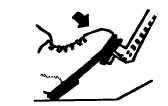| |
TM 10-3930-671-24
Operational Tests-Test Drive
NOTE
It is recommended that these tests be conducted with a
rated capacity load, if possible.
BUCKLE-UP - Always wear the seat belt when operating
a lift truck.
1.
Check all around to be sure that your intended
path of travel is clear of obstructions and
pedestrians.
2.
Test the truck for general correct operation and
drive train function by driving truck in both the
forward and reverse directions first in a straight
line and then, slowly, through a series of full right
and left turns.
3.
Test service brake operation. Apply and release
the brakes several times before driving the truck.
Note any change in pedal height each time pedal
is depressed. Changes in pedal height could
indicate air in the system or a fluid leak. Check
the brakes while driving to ensure proper
operation.
4.
Test transmission operation. Drive at various
speeds
and
operating
conditions
in
both
FORWARD and REVERSE. Listen for any
unusual drive train or other running noises, such
as wheel bearing noise, vibration, etc.
5.
When you have competed the operational tests,
park and leave truck according to standard
shutdown procedures.
6.
Make a record of all maintenance and operating
problems you find.
Lubrication, Fluids, & Filters
Check fluid levels and other components within the
engine compartment
Engine Cooling System
Do not remove the radiator cap when the radiator is hot.
Steam from the radiator can cause severe burns. Never
remove the radiator cap while the engine is running.
Stop the engine and wait until it has cooled. Even then,
use extreme care when removing the cap from the
radiator. It is good safety practice to use a shop cloth to
cover the radiator cap while it is being removed. Wrap
the cloth around the cap and turn it slowly to the first
stop. Step back while the pressure is released from the
cooling system. When you are sure all the pressure has
been released, press down on the cap with the cloth in
place, turn it and remove it. Stand clear of the radiator
opening; hot coolant may splash out. Failure to follow
these instructions could result in serious personal injury
from hot coolant or steam blowout and/or damage to the
cooling system or engine.
NOTE
Remove cap only when the engine is cold.
When servicing the engine coolant or checking coolant
level by removing the radiator cap:
a)
Turn the cap slowly to release any
pressure that may be in the radiator.
b)
Push the cap fully down and turn to
release and remove the cap.
F-49
|





